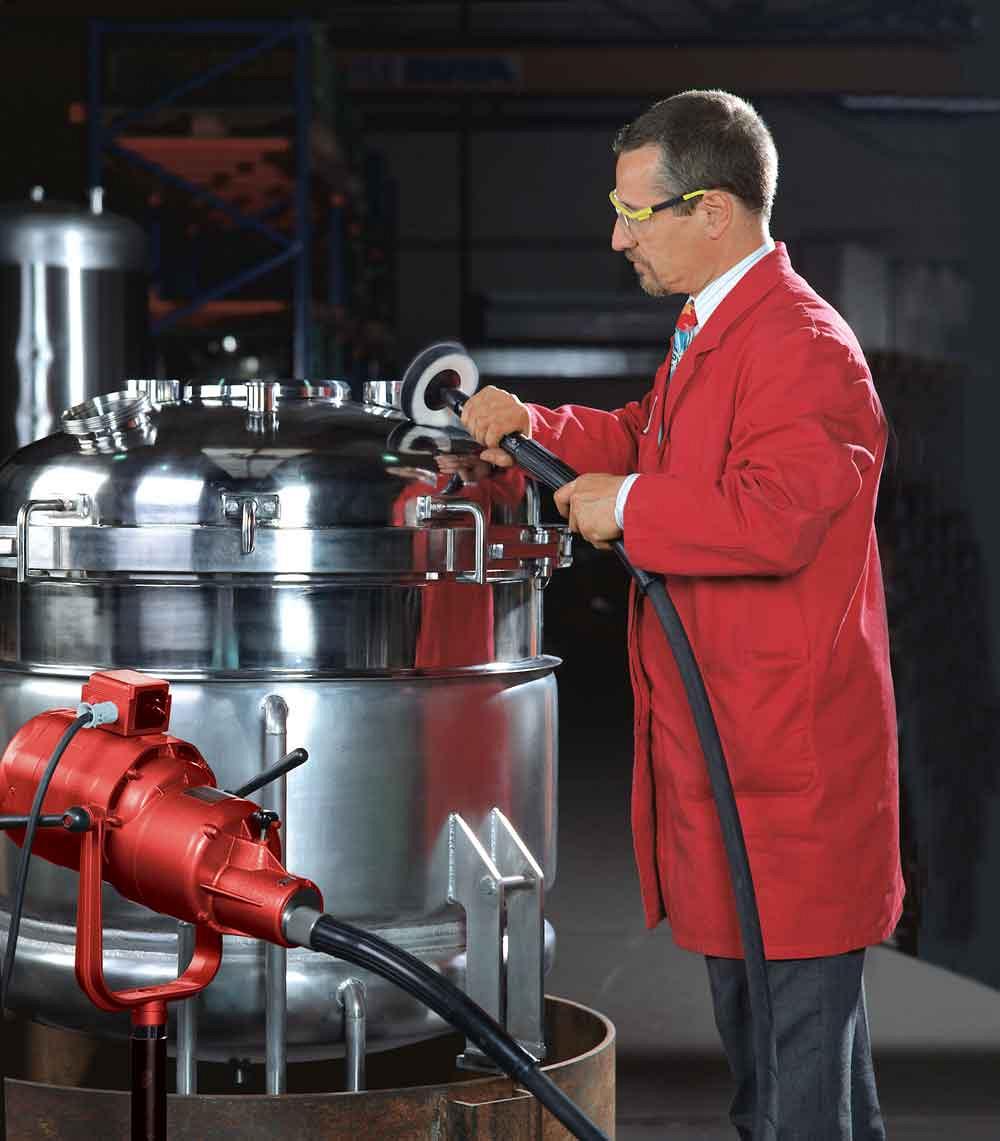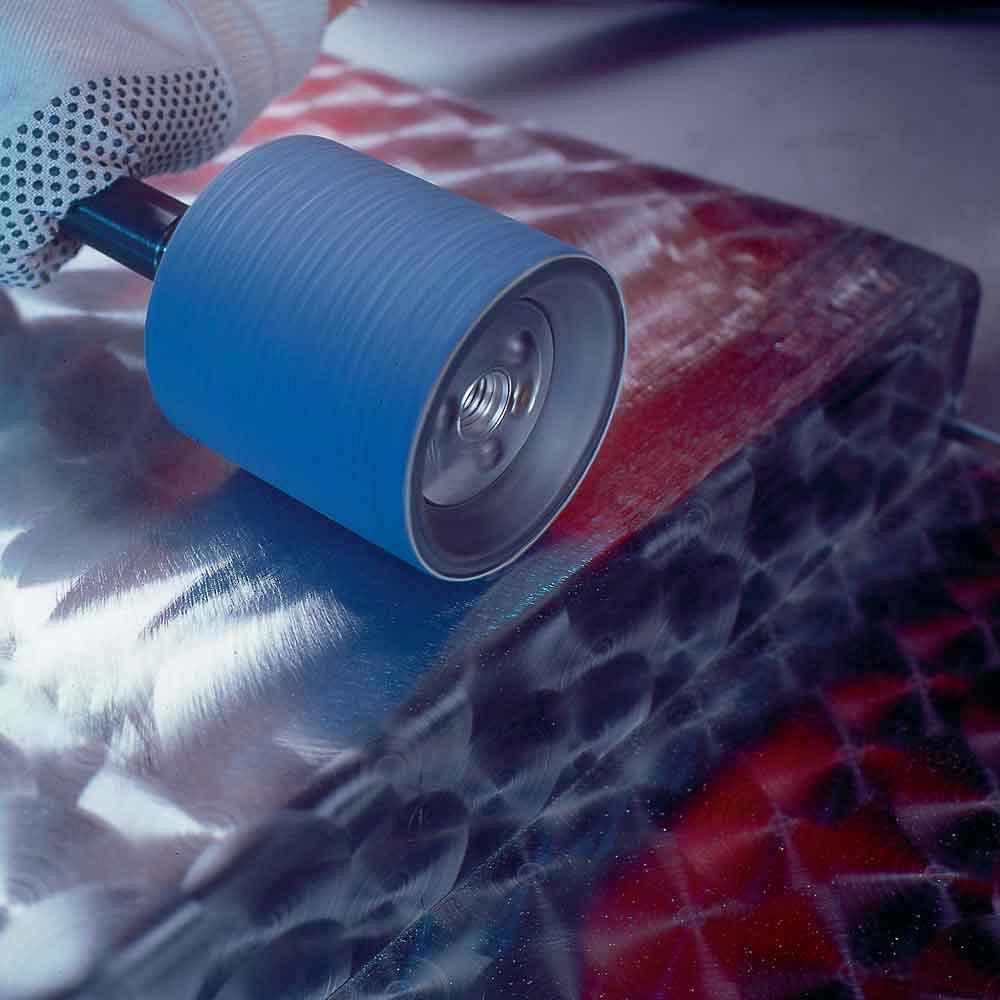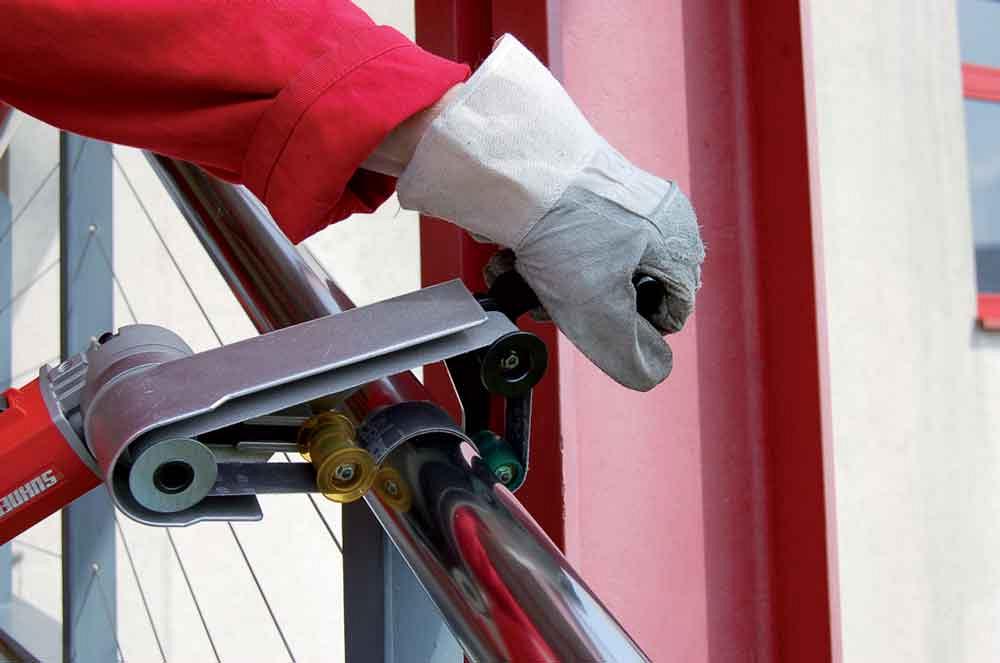- FMA
- The Fabricator
- FABTECH
- Canadian Metalworking
Nine Applications and Tips for Fine-grinding Stainless Steel
How to create a smooth surface on 9 applications
- By Aaron Beck
- Updated January 17, 2023
- October 17, 2016
- Article
- Metal Finishing

The final step in achieving a mirror finish on a stainless steel tube is using a buffing wheel and a polishing paste.
Fine grinding, by definition, is the blending of the weldment to the surface of the metal for a smooth, consistent, and attractive appearance. When you are working on stainless steel grades, whether for appliances, structural parts, unpainted or uncoated sheet metal housings that are visible, or architectural adornments, choosing the right equipment and consumables for each step of the process will help you produce the desired result.
Here are nine typical applications and tips on how you can use today’s hand-held grinding equipment and consumables to effect a better outcome in your shop or production department.
1. Blending Welded Connections on Railings
Blending welded surfaces on corners, squares, and rounds is the key to producing attractive welded connections on railings. Use 40-, 60-, or 80-grain belts in a belt grinder to grind down the weld. Then use a coarse, medium, fine, or ultrafine conditioning belt to blend the surface.
For flat surfaces, use an elastic drum and nonwoven nylon flat brush. For pipes and tubes, use a tube polishing wrap. Grain sizes to 320 will produce the desired results even on extremely small radii.
Using the correct regulated speed on the grinder will help you achieve the optimal finish, so choose tools with speed regulators. An adjustable belt grinder arm on the tool will make the tool easier to use, lessen operator fatigue, and yield better results.
2. Prepping and Finishing on Pressure Vessels
To achieve a typical No. 4 finish with RA 15-25 on a pressure vessel, use a 40- to 320-grain belt grind and finish with a flap brush. A satin finish can be achieved by using a nylon flap brush followed by polishing with a buffing wheel and a cutting/polishing compound.
Many popular tools offer quick-change tooling systems to reduce downtime, and many are portable. Operator fatigue is reduced when the portable tools have detachable handpieces so the weight of the entire drive unit doesn’t need to be carried. Some models are available for working in very confined and hard-to-reach places.
Look for dust-sealed units with low noise levels and vibration-free operation. Air-cooled induction motors provide long service life and minimum wear.

A nylon flap brush followed by polishing with a buffing wheel and cutting/polishing compound can create a satin finish on a pressure vessel.
3. Grinding Stainless Steel on Commercial Food Service Grills
Reducing surface weld beads is a key challenge when working on commercial-grade food service grills. Start by rough grinding with a pneumatic grinder with 36- to 80-grit discs. Finish-grind with a pneumatic drum with a 40- to 220-grit abrasive belt.
Then work all surfaces with an extended pneumatic straight grinder and 60 to 240-grit fibre brushes. Finishing discs of synthetic fibre, grit, and resin will eliminate welding discoloration.
4. Polishing Tubes to a Mirror Finish
To polish a stainless steel tube to a mirror finish, begin by preparing the surface with a belt grinder using an 80- to 120-grit zirconia belt. Then switch to a surface-conditioning belt for a medium to ultrafine finish. Use a pre-polish wheel and polishing compound.
Polish with a polishing wheel and polishing compound, then complete the mirror finish using a buffing wheel and a polishing paste.
5. Grinding Weld and Mitre Joints on Structural Steels
Remove the weld beads from structural steel mitre joints using 60- to 150-grit zirconium fibre discs. Then use a drum sander with a 40- to 220-grit zirconium-blend belt. Use a template.
Use a surface-conditioning belt for a fine finish. For a satin finish, use a 100-to 200-grit fine flap brush.
6. Graining of Steel Welds
Begin the graining process on a stainless steel weld with a pregrind using a pneumatic right-angle grinder with a plastic support plate with a cooling effect and an 80-grit fibre disc. Finish with a pneumatic drum using a straight grinder.
Grain the surface using a right-angle grinder with a nonwoven medium or high-hardness finishing disc. Grind the weld bead with a 120-grit grinding belt and a 40- to 320-grit finishing belt.
7. Eliminating the Orange Peel Effect When Grinding Stainless Steel
To smooth the orange peel effect, begin with a rough prep using a 40-grain belt. Then fine-grind it with a soft contact roller and A160 Trizact™ belt. Satin-finish with a soft contact roller and medium surface-conditioning belt.
You can achieve an industrial-grade finish by using a flap brush and 220 grain abrasive pad.
8. Grinding Stainless Steel Inside Corners
To finish the inside corners of a stainless steel component, begin by smoothing the weld with an electric angle grinder with an 80-grain mini flap wheel. Then fine-surface-grind using an electric angle grinder and soft disc--between an A160 and A16 grain--with a Trizact grinding wheel.
Use an electric file and nonwoven pads in the 60- to 400-grain range nonwoven pads to define the surface grain.
9. Grinding and Polishing Extruder Feeds
Start with a preliminary grind using a belt grinder and between a 40- and 80-grain zirconium corundum belt to grind and polish extruder feeds. Work the flanks with 80- to 120-grain Velcro® fibre wheels. Fine-grind the shaft and flanks with a roll attachment. Polish with twisted polishing rings and polishing paste.
The guidelines here provide a starting point to plan your finishing jobs, but most tool and abrasive suppliers are ready to offer suggestions for everyday or particularly challenging applications. If you have questions, take advantage of their experience.
Aaron Beck is national sales manager, abrasives and power tools, Suhner Industrial Products, 706-235-8046, www.suhner.com.
About the Author
subscribe now


Keep up to date with the latest news, events, and technology for all things metal from our pair of monthly magazines written specifically for Canadian manufacturers!
Start Your Free Subscription- Trending Articles
Orbital tube welding webinar to be held April 23

Portable system becomes hot tech in heat treatment

Cidan Machinery Metal Expo 2024 to be held in Georgia May 1-2

CWB Group launches full-cycle assessment and training program

Achieving success with mechanized plasma cutting

- Industry Events
MME Winnipeg
- April 30, 2024
- Winnipeg, ON Canada
CTMA Economic Uncertainty: Helping You Navigate Windsor Seminar
- April 30, 2024
- Windsor, ON Canada
CTMA Economic Uncertainty: Helping You Navigate Kitchener Seminar
- May 2, 2024
- Kitchener, ON Canada
Automate 2024
- May 6 - 9, 2024
- Chicago, IL
ANCA Open House
- May 7 - 8, 2024
- Wixom, MI

















